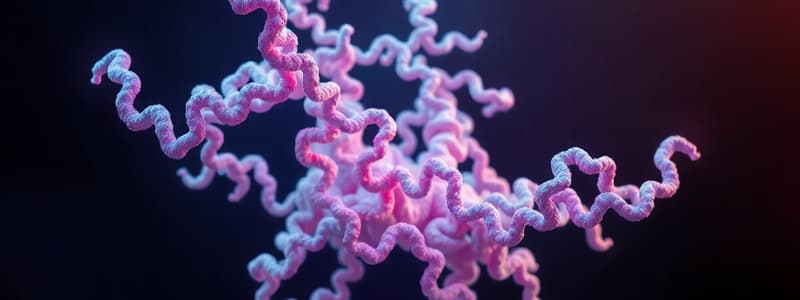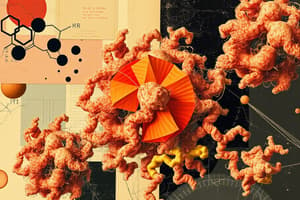Podcast
Questions and Answers
Which level of protein structure is most directly related to the protein's function?
Which level of protein structure is most directly related to the protein's function?
- Secondary Structure
- Quaternary Structure
- Tertiary Structure (correct)
- Primary Structure
The primary structure of a protein can be easily deduced from its tertiary structure.
The primary structure of a protein can be easily deduced from its tertiary structure.
False (B)
What is the tertiary structure of a protein?
What is the tertiary structure of a protein?
It is the three-dimensional structure of a protein, formed by the folding and interactions of its secondary structural elements.
In X-ray crystallography, a protein's structure is determined through the analysis of its ______ pattern.
In X-ray crystallography, a protein's structure is determined through the analysis of its ______ pattern.
Match the following protein structure determination methods with their key characteristic:
Match the following protein structure determination methods with their key characteristic:
What is the primary advantage of using X-ray crystallography to determine a protein's structure?
What is the primary advantage of using X-ray crystallography to determine a protein's structure?
Homology modeling can accurately predict protein structure even when there is very low sequence identity between the query sequence and the template.
Homology modeling can accurately predict protein structure even when there is very low sequence identity between the query sequence and the template.
What is the main purpose of homology modeling in protein structure prediction?
What is the main purpose of homology modeling in protein structure prediction?
In homology modeling, the method relies on finding a suitable ______ sequence with a known structure for structure prediction.
In homology modeling, the method relies on finding a suitable ______ sequence with a known structure for structure prediction.
How does 'threading' or 'fold recognition' differ from homology modeling in protein structure prediction?
How does 'threading' or 'fold recognition' differ from homology modeling in protein structure prediction?
Ab initio protein modeling relies exclusively on experimental data to determine protein structure.
Ab initio protein modeling relies exclusively on experimental data to determine protein structure.
What is the role of a 'template library' in the threading method of protein structure prediction?
What is the role of a 'template library' in the threading method of protein structure prediction?
Unlike homology modeling, ______ modeling techniques predict protein structures from scratch, using physical principles and computational power.
Unlike homology modeling, ______ modeling techniques predict protein structures from scratch, using physical principles and computational power.
Which method is a hierarchical approach to protein structure prediction and structure-based function annotation by using multiple threading approaches?
Which method is a hierarchical approach to protein structure prediction and structure-based function annotation by using multiple threading approaches?
Machine learning has no use in protein structure determination.
Machine learning has no use in protein structure determination.
How does machine learning contribute to advancements in protein structure prediction?
How does machine learning contribute to advancements in protein structure prediction?
Machine learning enables computers to learn without being ______ programmed, improving algorithms for protein structure prediction.
Machine learning enables computers to learn without being ______ programmed, improving algorithms for protein structure prediction.
What is a key outcome of using protein modeling in various scientific applications?
What is a key outcome of using protein modeling in various scientific applications?
Protein modeling outputs are exclusively used in academic research and have limited applications in biotechnology or medicine.
Protein modeling outputs are exclusively used in academic research and have limited applications in biotechnology or medicine.
Give one application of protein modeling in the field of medicine or biotechnology.
Give one application of protein modeling in the field of medicine or biotechnology.
Protein modeling aids drug discovery by allowing researchers to understand how drugs interact with target proteins through molecular ______.
Protein modeling aids drug discovery by allowing researchers to understand how drugs interact with target proteins through molecular ______.
Which of the following is a future application of protein modeling?
Which of the following is a future application of protein modeling?
Current protein modeling techniques are sufficient to fully replace traditional experimental methods in all areas of protein research.
Current protein modeling techniques are sufficient to fully replace traditional experimental methods in all areas of protein research.
What is one area of future development for protein modeling in synthetic biology?
What is one area of future development for protein modeling in synthetic biology?
Metagenomic gene mining and synergy with protein engineering approaches represents a big area for future application and development of protein modelling such as ______ evolution.
Metagenomic gene mining and synergy with protein engineering approaches represents a big area for future application and development of protein modelling such as ______ evolution.
What is indicated by the Nobel Prize received for protein structure prediction?
What is indicated by the Nobel Prize received for protein structure prediction?
The advent of AlphaFold and similar AI models has completely eliminated the need for traditional methods like X-ray crystallography in determining protein structures.
The advent of AlphaFold and similar AI models has completely eliminated the need for traditional methods like X-ray crystallography in determining protein structures.
Explain how AlphaFold contributes to advances in synthetic biology and the development of artificial enzymes?
Explain how AlphaFold contributes to advances in synthetic biology and the development of artificial enzymes?
AlphaFold is improving structure prediction accuracy, facilitating design and development of custom ______ enzymes.
AlphaFold is improving structure prediction accuracy, facilitating design and development of custom ______ enzymes.
What is the relationship between a protein's primary structure and its potential conformations?
What is the relationship between a protein's primary structure and its potential conformations?
Flashcards
Primary structure
Primary structure
The linear sequence of amino acids in a protein's chain.
Tertiary structure
Tertiary structure
The three-dimensional arrangement of atoms in a protein.
X-ray crystallography (Advantages)
X-ray crystallography (Advantages)
A reliable, error-limited method to determine tertiary structure. Has been an academic standard for over 50 years and until recently, the only reliable way to determine tertiary structure of a novel protein.
Types of protein modelling
Types of protein modelling
Signup and view all the flashcards
Homology modeling
Homology modeling
Signup and view all the flashcards
Homology modeling: Sequence Identity
Homology modeling: Sequence Identity
Signup and view all the flashcards
Threading/fold recognition
Threading/fold recognition
Signup and view all the flashcards
Ab Initio Modelling
Ab Initio Modelling
Signup and view all the flashcards
Machine learning
Machine learning
Signup and view all the flashcards
Applications of protein modelling
Applications of protein modelling
Signup and view all the flashcards
Future applications for protein modelling
Future applications for protein modelling
Signup and view all the flashcards
Study Notes
Lecture Overview
- The lecture will cover tertiary structure and its importance, the difference between primary and tertiary structure, X-ray crystallography, the basis for protein modeling, AlphaFold and machine learning approaches, and future benefits.
TDO Components
- TDO α- and β-components have over 400 amino acids
- TDO amino acid backbones have bound substrates and secondary structures.
- Hydrophobic interactions in the active site measure less than 5.0 Å (e.g., Van der Waals interactions)
- 1 angstrom (Å) equals 1.0 × 10-10m.
- Hydrophobic interactions in the active site measure less than 3.8 Å.
Primary vs. Tertiary Structure
- Primary structure describes the linear sequence of amino acids in a protein chain and is useful from an evolutionary perspective.
- Primary structure cannot determine protein function.
- Tertiary structure is not easily deduced from the primary sequence
- Tertiary structure reveals more about the protein function
- Tertiary structure can provide evolutionary insights beyond the primary structure.
X-Ray Crystallography
- X-ray crystallography helps to determine the protein structure from crystal to a diffraction pattern, then to an electron density map, and finally a protein model.
- X-ray crystallography is the most reliable, error-limited method for showing tertiary protein structure and has been an academic standard for over 50 years
- X-ray crystallography was the only reliable method to determine the tertiary structure of a completely novel protein.
- X-ray crystallography has limitations such as difficulty with proteins like membrane proteins, the need for expertise and equipment, time consumption, expenses and the possibility that a structure solution may fail.
Homology Modeling
- Homology modeling's minimum amino acid identity is 30% but ideally >50%.
Protein Structure of Proteins
- Primary protein structure is the sequence of a chain of amino acids.
- Secondary structure involves local folding of the polypeptide chain into helices or sheets.
- Tertiary structure is a three-dimensional folding pattern of a protein resulting from side chain interactions.
- Quaternary structure is a protein consisting of more than one amino acid chain.
Threading
- Threading uses the fold pattern of a similar protein as the template, not on sequence identity.
- Prediction via threading involves a protein sequence and a library of core templates, where the return is the best alignment of the sequence to a template.
Protein Modelling
- Outputs from protein modeling have a variety of applications across a broad range of sciences, including molecular docking, computer-aided drug discovery, and improving QSAR results.
- It helps to overcome the limitations of protein crystallography and saves especially time and resources.
Machine Learning
- Machine learning gives computers the ability to learn without being explicitly programmed.
Future Applications
- Advances in research and biotechnology/medicine are developing the fields of synthetic biology: in vivo optimization/evolution, metagenomic gene mining, synergy with protein engineering approaches such as directed evolution, and creating artificial enzymes.
Studying That Suits You
Use AI to generate personalized quizzes and flashcards to suit your learning preferences.




